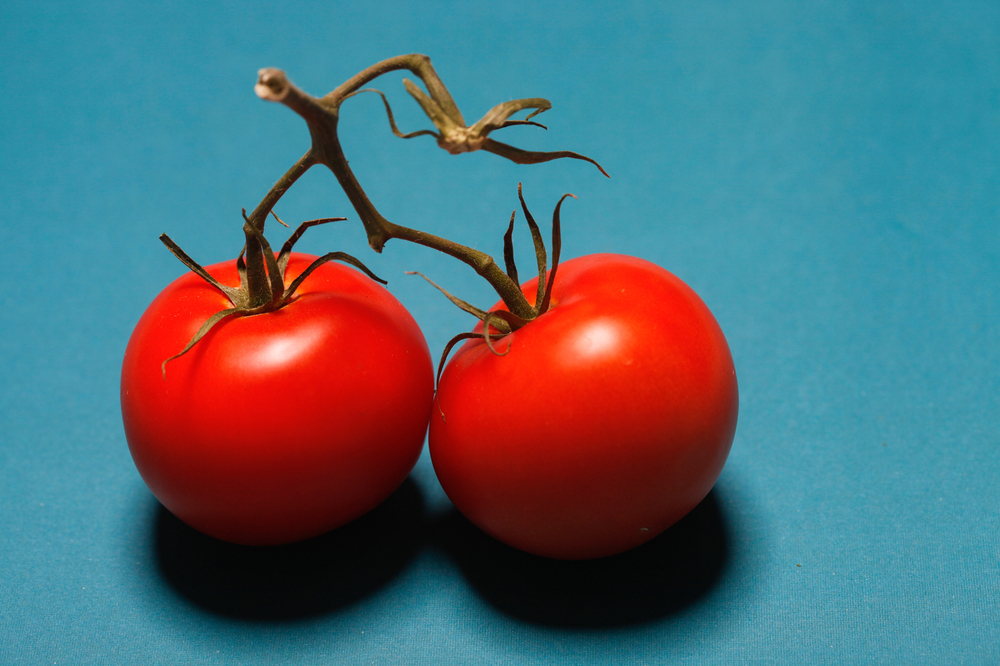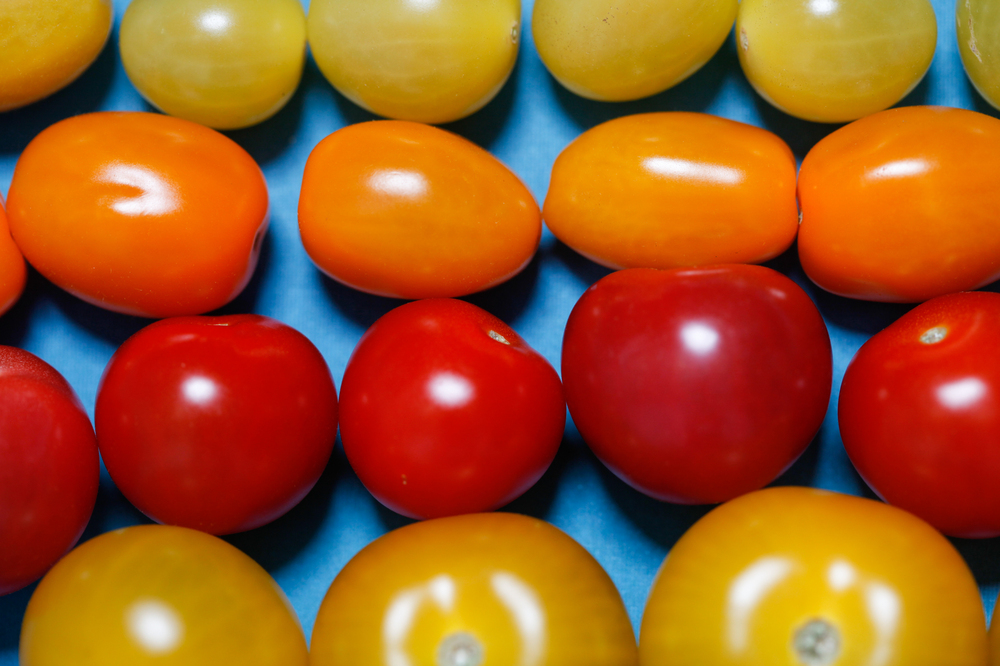One of my fondest childhood memories is of eating tomatoes. We picked them in the garden and ate them in sandwiches, sitting on a picnic table under the trees outside our house. That juicy, acidic taste is forever lodged in the pleasure centers of my brain.
For anyone with similar memories, supermarket tomatoes are bound to disappoint. Indeed, the classic supermarket tomato — hard, tasteless, sometimes mealy — has inspired countless bitter complaints.
Take a closer look at the tomato display in your local grocery store, though, and you'll notice some big changes.
Here's how. It's a three-act drama.
Act 1. The Florida tomato

Florida tomato
For many years, until about 25 years ago, this was mainly what you'd find in the store during wintertime. So let's give this tomato its due: It is there in front of you, in the heart of winter, hundreds of miles from the field where it grew. Also, it's pretty cheap.
To accomplish that feat, this tomato has to be tough. In the field, it has to deal with wind, rain, insects and plant diseases. After picking, it has to survive sorting, packing, trucking, and the supermarket shelf. Consumers like tomatoes that are big. And growers, to stay in business, need to ship as many of the fruit as possible.
So tomato breeders have delivered exactly what the market demanded: a big, tough, high-yielding tomato. Taste hasn't had the same priority.
In addition, to make sure these tomatoes get to the store in presentable shape, they are picked while they are still green. The fruit turn red on their way to the consumer, and some tomato experts insist that they get just as ripe as they would have on the vine, but others admit that these tomatoes never will approach the taste and flavor of a tomato that's picked ripe.
Act 2. The Mexican tomato

Mexican tomatoes
Over the past two decades, Mexico has turned into a tomato powerhouse. And it's brought a new production style to supermarket tomatoes.
Most Mexican tomatoes now grow inside simple plastic greenhouses called shade houses that cover vast fields. The plants grow in the soil, but they are protected from the rain, wind and many of the insects that afflict field-grown tomatoes.
It gives these tomatoes two advantages. First, they can stay on the vine just a bit longer, allowing more natural ripening. Second, in contrast to the open-field farmers of Florida, shade-house tomato producers grow "indeterminate" tomato varieties. These plants produce fruit continuously for a longer period of time. According to Robert Heisey, a tomato breeder at United Genetics in Hollister, Calif., fruit from such plants typically have higher levels of the soluble solids that provide much of a tomato's flavor.
On the other hand, these tomatoes still have to be big and tough. The typical Mexican tomato may taste a bit better than its Florida cousin, but probably not by much.
Act 3. Greenhouse tomatoes

Canadian tomatoes grown in greenhouses
Meet the most pampered tomatoes on Earth. They grow in huge climate-controlled structures, often in Canada, sometimes in Mexico and only occasionally in the United States. (The U.S. has been a laggard in the greenhouse business, although that's starting to change.)
Companies in the Netherlands pioneered this technology and have exported it to the rest of the world. In greenhouses, tomato plants don't grow in soil at all, but rather in crushed stone or coconut husks. Nutrients and water arrive via plastic tubes. Sometimes, extra carbon dioxide is added to the air in these houses, to promote faster plant growth.
I visited a tomato-growing greenhouse recently that's operated by Mastronardi Produce Sunset Grown, a major tomato grower and distributor based in Kingston, Ontario. Before I got close to the tomato plants, I first had to put plastic booties on my shoes, wear a special lab coat and wash my hands. It was all intended to keep me from tracking in plant diseases.
This ultra-protected style of tomato production has opened the door to an entirely new family of tomato varieties.
Tomatoes-on-the-vine made their appearance some 20 years ago. More recently, there's been a proliferation of small tomatoes that come packaged in plastic containers. Supermarket shelves are now filled with cherry tomatoes, grape tomatoes, and tomatoes the size of golf balls. Almost all of them come from high-tech greenhouses.
And because these tomatoes are protected while they are growing, and handled more gently while they're packed and shipped, it means that — in theory, at least — these tomatoes can offer better flavor. They can be picked when ripe, and bred for flavor rather than for toughness.
That's the opportunity that Paul Mastronardi glimpsed when he joined the family business in the 1990s.
"I went over to Holland and talked to a couple of the major seed companies, and said, 'Listen, I want to see everything that's in your kitchen,' " he says. " 'Forget about size. Let's just see everything you got. Let's start doing taste tests.' And that's when we found a variety called Campari, which became the first branded tomato."
Mastronardi says they're constantly looking for new varieties with superior flavor. In the company's administrative offices, there's a lineup of candidate tomatoes on display. Employees can stop by, sample them and rate each one.
The seeds for such new varieties may be the most expensive seeds in the world. According to sources in the industry, greenhouse operators are paying about a dollar per seed for Campari and similar tomatoes. Since tomato seeds are tiny, that translates to about $150,000 per pound of seed. (In case you're wondering: No, you can't retrieve seeds from a Campari tomato and sell them for this price. Campari tomatoes are genetic hybrids, so their seeds won't produce true Campari offspring.)
Even greenhouse producers, though, have to navigate the tension between taste and economic efficiency. Heisey, the tomato breeder, recently picked up some tomatoes in the store and measured their levels of soluble solids, an indicator of flavor. "The greenhouse tomatoes were terrible," he says. He suspects that greenhouse operators, too, are emphasizing quantity of production over quality.
Nor are greenhouse varieties like Campari the only attempts to deliver a better-tasting supermarket tomato. Researchers at the University of Florida have also come come up with new varieties that promise superior taste, and they can be grown in open fields.
No matter what the variety, though, tomatoes have to get special treatment in order to deliver that great flavor. They have to be grown carefully, harvested when they're mature, and treated gently on the way to market. The result? They're also more expensive. When I visited a grocery store close to NPR recently, tomatoes from Florida and Mexico were selling for $2.50 a pound. A pound of Campari tomatoes cost $4.
9(MDE1MTIxMDg0MDE0MDQ3NTY3MzkzMzY1NA001))
300x250 Ad
300x250 Ad
